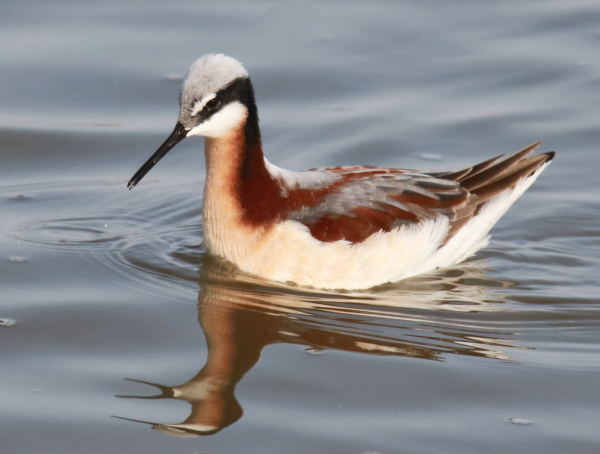
The first flocks of Wilson’s Phalaropes added an array of action to the edge of a wetland populated by a variety of shorebirds and ducks.
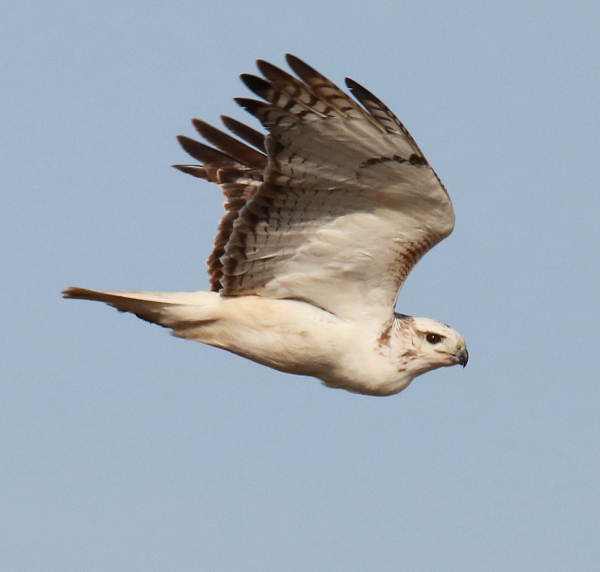
After years of photo avoidance, this light-colored Krider’s Red-tailed Hawk was intercepted on the wing as it circled back to its perennial nest site.
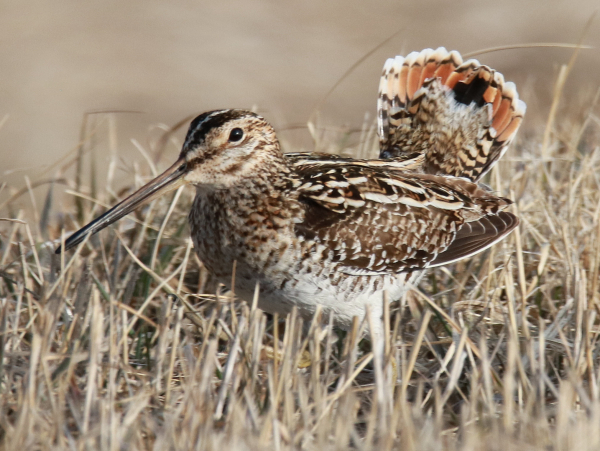
As a pair of Wilson’s Snipe performed “strutting” displays and “ground chase” displays, this photo showed the fanned tail of the male.
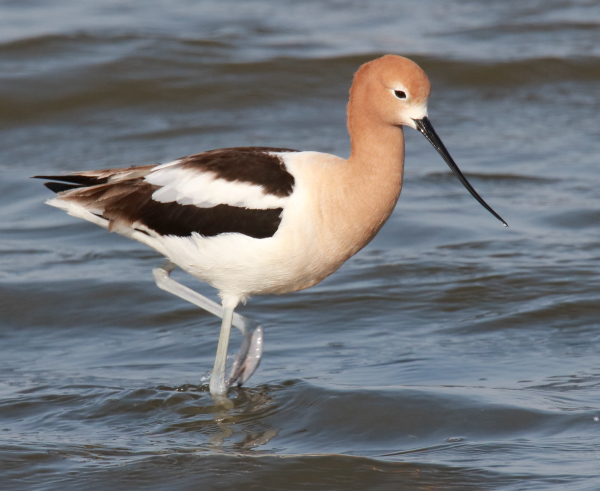
American Avocets are always elegant additions to the open shorelines of area marshes. More shorebirds arrived during the past week, with more to come.
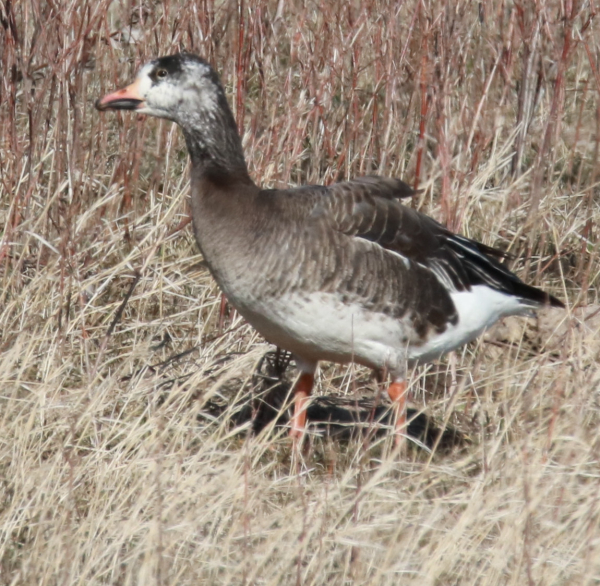
Although it was difficult to get a comparison photo, this image shows the hybrid near one of the White-fronted Geese.
|
More first spring sightings: Wilson’s Phalaropes, an Upland Sandpiper, Wilson’s Snipe, Lesser Yellowlegs, Long-billed Dowitchers, Eastern Phoebe, Brown-headed Cowbirds, and Song Sparrows in the field; plus new to my yard were a Harris’s Sparrow, Ruby-crowned Kinglet, and a Chimney Swift overhead. While birding Thursday afternoon, it was pretty obvious there was a migration influx overnight with photo highlights provided by Bonaparte’s Gulls, Wilson’s Snipe, Wilson’s Phalaropes; and Belted Kingfishers, with a special female that was the most trusting kingfisher I’ve had a chance to spend time with. The exciting photos that resulted are provided in this issue’s Bird Photography feature.
At another location I had the first Lesser Yellowlegs, an American Avocet, and a couple flocks of Wilson’s Phalaropes that I keyed in on photographically for a while with fine successes and lots of fun action. Down the road, I photographed a pair of Marbled Godwits, but a hundred yards beyond them I witnessed something I’ve never seen before: A pair of Wilson’s Snipe displaying by flaring and elevating their tails. As they walked in front of one another, each one twisted their tail so it was spread toward the other bird, showing the rufous-orange color of the dorsal side of the tail. It was exciting to witness and the snipe were especially quick as I tried to photograph them as they made their way through grass and in and out of good light for just a couple minutes. When the snipe repositioned in full sunlight, I was pleased to get a few photos that illustrate the display.
On down the road, a Red-tail flushed from an open prairie area, and I didn’t think twice about it until I realized it was a Krider’s Red-tailed Hawk, so as it flew in a half-circle around me I took a series of photos, the first of which turned out to be the best. And that’s when I realized this was undoubtedly the Krider’s male that uses the nest site a half-mile to the west. It is such a rare white morph hawk that it is essentially a marked bird, and it has nested in this location year after year for the 6 years I’ve been back in Dakota. However, it has been a very wary bird and it turns out that this is the first sharable photo of the bird I have been able to get. Has it softened its distrust, or did I just get lucky this one time?
That evening as I did a few things around the yard, and when I checked later in the dark of night, I welcomed the almost constant winnowing calls as snipe performed their display flights nearby, and sometimes overhead.
Cross Coteau & River Run
The day before, I was interested to check the region’s migration status to the west, so took a Wednesday drive across the Coteau, then up the east side of the Missouri River to Bismarck. Along the way, ducks were dominant across the Coteau, but not as abundant as in my home range. It was also interesting to see that little falcons were the most common raptors with 14 American Kestrels tallied along the way, plus 5 Red-tailed Hawks, and a Bald Eagle standing on the shore of the Missouri River – but no Swainson’s Hawks yet; hmm.
Yard Action
Last Tuesday’s birds underlined the worth of keeping some of my yard “messy;” that is, as usual I left the fallen leaves under my thickets of bushes – the choke cherries, the lilacs, and the sumacs. That leaf litter was golden when I noticed at least 4 Fox Sparrows, 7+ White-throated Sparrows, and many Dark-eyed Juncos that were busy scratching among the leaves, gleaning bugs and seeds and worms and such – could White-crowned and Harris’s Sparrows be far behind?
Wednesday I was happy to see another Brown Creeper working a couple of my elm trees. Thursday I had a Fox Sparrow and a pair of Chipping Sparrows appear, and Friday, during a lull in the rain I had a Yellow-rumped Warbler and the first Ruby-crowned Kinglet in the elm trees outside my front door. Rain dictated a break in birding, even in my yard, until Monday when a striking fully-colored adult Harris’s Sparrow materialized, along with another Ruby-crowned Kinglet and an adult White-crowned Sparrow. Daily, my feeding station was still graced by the little Red-breasted Nuthatch, White-breasted Nuthatches, House Finches, Downy Woodpeckers, and Hairy Woodpeckers too.
Beyond my yard, I spied a rare Eastern Phoebe (very rare in this area) on the edge of Melody’s Grove – a songbird and flycatcher migrant hotspot that was producing the first migrants of May, including a Hermit Thrush sighted earlier. Mid-May will reveal the glory of Melody’s Grove when a variety of warblers, vireos, orioles, thrushes, native sparrows, flycatchers, and more grace this little tree grove that stands out like a beacon on the wide open plains that surround it on 3 sides.
Monday Migrants & Hybrid
Monday, just a half-mile south of home, a small flock of White-fronted Geese was grazing on the edge of Melody’s Marsh, when something caught my eye, warranting a second look. One of the geese resembled the other White-fronts, but it had a mostly white head – it was definitely an unusual goose. A few minutes of study suggested this was a hybrid Arctic goose – a White-fronted x blue Snow Goose! It had a base plumage of a White-front, but its white face and upper neck resembled features of an adult blue morph Snow Goose. The blue morph qualities continued with the white belly of the hybrid, and its black flight feathers. Very interesting!
In addition, cloudy Monday revealed the results of a migration, including a few new spring birds: A surprise Upland Sandpiper, a flock of 19 Long-billed Dowitchers, 4 male Brown-headed Cowbirds, and 2 immature Black-crowned Night Herons. It was evident there was an out migration of ducks, but there were a couple new flocks of Ruddy Ducks, one numbering about 30, plus a couple male Wood Ducks were new too. After not seeing Swainson’s Hawks for a week, there was one soaring over a familiar Swainson’s territory 6 miles to the south, and a pair was perched a mile south of there.
It was exciting to see migration back in action after the rainy days, and I look forward to sunny days ahead with more migrants to come. May holds great promise for birders and I hope you have a chance to dedicate time to search out your local birds – in your yard, in your neighborhood, and in the field. Give your binoculars and camera a good workout every May day possible – Enjoy!
Article and photos by Paul Konrad
Share your bird sightings and photographs at editorstbw2@gmail.com